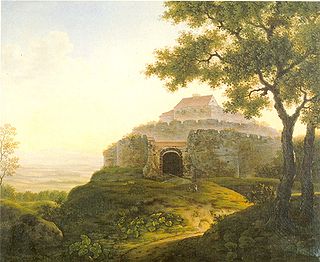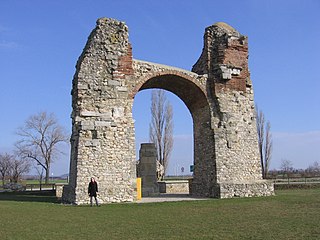
The Saalburg is a Roman fort located on the main ridge of the Taunus, northwest of Bad Homburg, Hesse, Germany. It is a cohort fort, part of the Limes Germanicus, the Roman linear border fortification of the German provinces. The Saalburg, located just off the main road roughly halfway between Bad Homburg and Wehrheim is the most completely reconstructed Roman fort in Germany. Since 2005, as part of the Upper German limes, it forms part of a UNESCO World Heritage site. In the modern numbering system for the limes, it is ORL 11.

Wirtemberg Castle, a ruined hilltop castle, is the second family seat of the House of Württemberg, whose ancestors had abandoned Beutelsbach Castle. Built on the eponymous Württemberg mountain in a spur of the Schurwald around 411 m (1,348 ft) above sea level, it is located in the current municipality of Rotenberg in Stuttgart, between Bad Cannstatt and Esslingen am Neckar. Between 1080 and 1819, three castles with this name existed in the area.

Amlishagen Castle is a castle near the village of Amlishagen, which is a section of the town of Gerabronn, in the Schwäbisch Hall District of Baden-Württemberg, Germany.

A grave field is a prehistoric cemetery, typically of Bronze Age and Iron Age Europe.
The Ceram Prize is a prize for non-fiction books in archaeology issued by Rheinisches Landesmuseum Bonn. It is named for C. W. Ceram, famous for his popularization of archaeology.
Werner Eck is Professor of Ancient History at Cologne University, Germany, and a noted expert on the history and epigraphy of imperial Rome. His main interests are the prosopography of the roman ruling class and the ancient city of Cologne, Colonia Claudia Ara Agrippinensium. He also researched the Bar Kokhba Revolt from the Roman point of view.

The Augsburg Victory Altar is the name given to a Roman altar of the victory goddess Victoria, which was set up on the occasion of the victory of a Roman army over the tribe of the Juthungi near the Rhaetian provincial capital Augusta Vindelicorum. The mention of the rebel emperor Postumus dates the creation of the altar to 11 September 260. The stone is kept in the Römisches Museum Augsburg.

The Upper Germanic-Rhaetian Limes, or ORL, is a 550-kilometre-long section of the former external frontier of the Roman Empire between the rivers Rhine and Danube. It runs from Rheinbrohl to Eining on the Danube. The Upper Germanic-Rhaetian Limes is an archaeological site and, since 2005, a UNESCO World Heritage Site. Together with the Lower Germanic Limes it forms part of the Limes Germanicus.

The Roman fort at Weissenburg, called Biriciana in ancient times, is a former Roman Ala castellum, which is a UNESCO World Heritage Site located near the Upper Germanic-Rhaetian Limes. It lies in the borough of Weißenburg in the Middle Franconian county of Weißenburg-Gunzenhausen in Germany. Today the castellum is one of the most important sites of research in the Roman limes in Germany. The site contains partly subterranean building remains, a reconstructed north gateway, large thermal baths and a Roman Museum with an integrated Limes Information Centre.

The Lower Germanic Limes is the former frontier between the Roman province of Germania inferior and Germania Magna. The Lower Germanic Limes separated that part of the Rhineland left of the Rhine as well as the Netherlands, which was part of the Roman Empire, from the less tightly controlled regions east of the Rhine.

The Neckar-Odenwald Limes is a collective term for two, very different early sections of the Upper Germanic-Rhaetian Limes, a Roman defensive frontier line that may have been utilised during slightly different periods in history. The Neckar-Odenwald Limes consists of the northern Odenwald Limes (Odenwaldlimes), a cross-country limes with camps, watchtowers and palisades, which linked the River Main with the Neckar, and the adjoining southern Neckar Limes (Neckarlimes), which in earlier research was seen as a typical 'riverine limes', whereby the river replaced the function of the palisade as an approach obstacle. More recent research has thrown a different light on this way of viewing things that means may have to be relativized in future. The resulting research is ongoing.
The Alb Limes is a Roman frontier fortification or limes of the late 1st century AD in the Swabian Jura, also known as the Swabian Alb. The Alb Limes runs for just under 135 kilometres from Rottweil in the southwest to Heidenheim an der Brenz in the northeast.

The Pannonian Limes is that part of the old Roman fortified frontier known as the Danubian Limes that runs for approximately 420 km (260 mi) from the Roman camp of Klosterneuburg in the Vienna Basin in Austria to the castrum in Singidunum (Belgrade) in present-day Serbia. The garrisons of these camps protected the Pannonian provinces against attacks from the north from the time of Augustus (31 BC-14 AD) to the beginning of the 5th century. In places this section of the Roman limes also crossed the river into the territory of the barbarians (Barbaricum).
Pfünz Roman Fort, Castra Vetoniana or Vetonianae, was a Roman cohort camp near Pfünz, a village in the municipality of Walting in the county of Eichstätt, Bavaria. It was built in about 90 A. D. on a 42-metre-high Jurassic hillspur between the valley of the Altmühl and that of the Pfünzer Bach stream. it is a component of the Rhaetian Limes which was elevated in 2005 to the status of a UNESCO World Heritage Site. Of historical importance are the remains of the double V-shaped ditches hewn out of the rock in front of the position, the one on the western rampart being the best preserved. In 1998, as part of the construction of a high pressure water system, the Bavarian State Office for Monument Protection carried out further test excavations. The archaeological record and rich finds from Pfünz, some of which are very rare, are seen as reasons for further studies in the future.

The Venus figurines of Petersfels are several small female statuettes from the Upper Paleolithic era, carved from jet lignite. The tallest figurine is called the Venus of Engen. The figurines were discovered in the Petersfels caves near Engen, Baden-Württemberg, excavated in 1927–1932 by Eduard Peters und Volker Toepfer and then in 1974–1976 and 1978 by Gerd Albrecht. They stand between 1.5 and 4 cm tall and are about 15,000 to 11,500 years old, created during the Magdalenian era. They are housed in the Museums of Freiburg im Breisgau and Engen.
The Main Limes, also called the Nasser Limes, was built around 90 A. D. and, as part of the Upper Germanic-Rhaetian Limes, formed the frontier of the Roman Empire in the area between the present day villages of Großkrotzenburg and Bürgstadt. In this section the limes adjoined the River Main (Moenus), which forms a natural boundary for about 50 kilometres here, so "Main" refers to the river.

The Wetterau Limes is the name given in the field of historical research to that part of the Upper Germanic-Rhaetian Limes which enclosed the region that became known later as the Wetterau in the German state of Hesse.
The Lautertal Limes is a Roman limes section of the early 2nd century which is located between the River Neckar and the Swabian Jura. It extends for a distance of 23 kilometres (14 mi), running, straight as a die, from the present-day municipality of Köngen on the Neckar in the northwest to Donnstetten in the Swabian Jura to the southeast.

The Danube–Iller–Rhine Limes or DIRL was a large-scale defensive system of the Roman Empire that was built after the project for the Upper Germanic-Rhaetian Limes in the late 3rd century AD. In a narrower sense the term refers only to the fortifications between Lake Constance and the River Danube (Danubius); in a broader sense it also includes the other Late Roman fortifications along the river Rhine (Rhenus) on the High Rhine(between Lake Constance and Basle) and on the Upper Rhine as well as the Upper Danube.
Matthias Untermann is a German art historian and medieval archaeologist.












